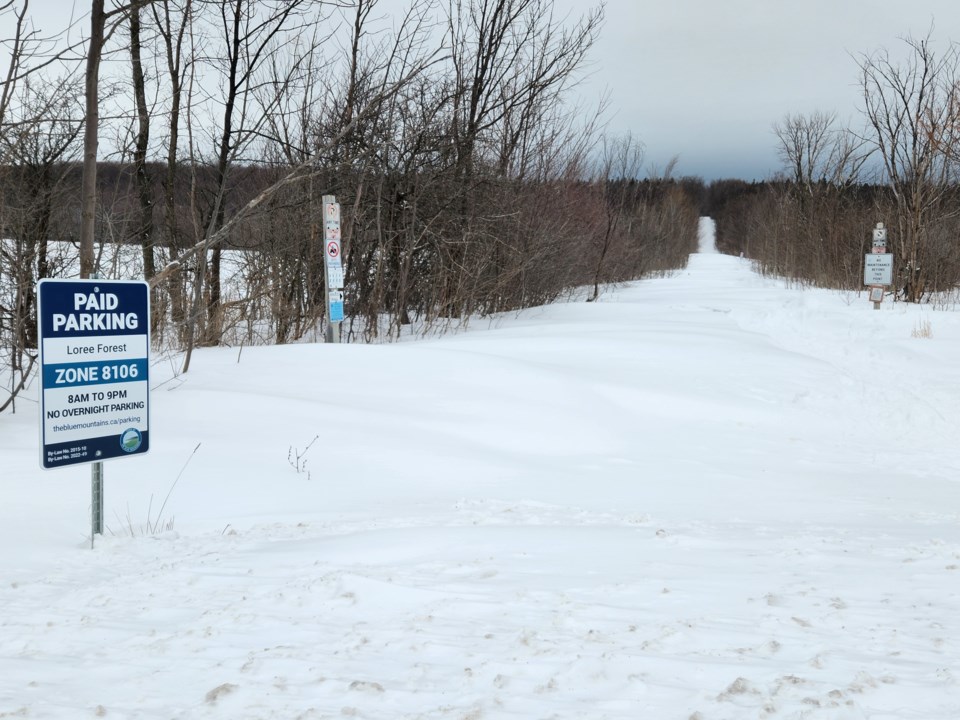The Blue Mountains council will consider lowering some parking fees after a large group of hikers and trail users raised complained about the cost.
The public galleries at the council chambers were filled at the Feb. 27 committee of the whole meeting, as a number of local hikers and trail enthusiasts raised objections to the town’s recent changes to implement paid parking and no parking zones on roads around local parks and trails.
Patricia Dunbar and Heather McCleary were an official delegation at the meeting to speak to council about the issue at several parks including: Pretty River Provincial Park, Margaret Paul Side Trail and Loree Forest. In addition, a number of speakers from the Town of Collingwood also addressed council about the matter.
McCleary told council many local hikers and parks users are feeling frustrated by the “drastic restrictions” that have come into effect when parking at or near local parks.
“We sincerely hope you will listen to our appeal,” said McCleary.
In response to an explosion of interest and traffic at local parks, which have limited parking capacity, during the COVID-19 pandemic the town implemented no parking zones on roads around the parks and brought in paid parking ($10 per hour).
In a letter to council that was part of the agenda, Dunbar and McClearly objected to the new measures.
“We were dismayed to discover that TBM has implemented some extreme restrictions in the form of no parking anywhere close to trails and parking fees,” they said in the letter.
Dunbar said that hiking and usage of local parks and trails is an enjoyable activity to many local residents.
“Hiking the trails is one of the few activities freely available to individuals of all income levels,” she said. “We believe the town should be promoting hiking as a healthy outdoor activity.”
Director of Operations Shawn Carey said the limited parking facilities at the parks and the significant increase in usage during the pandemic led to safety issues with cars parking on both sides of the nearby roads and concerns about residents’ driveways being blocked. Carey said the issue of how much parking is needed at those parks is a tough question.
“Is it ever going to be enough? It is a difficult balance,” he said. Carey said the town is anxious to work collaboratively with all parties to find appropriate solutions.
CAO Shawn Everitt explained that the town is limited in what it can do about parking issues as it does not own a lot of land in the rural areas. He said it would take cooperation from various levels of government to solve the problem.
“This has to be a package that gets put together. There is lots of work being done here. Residents have to go to the province as well. They are the entity that has the land,” he said.
Everitt stressed that, for the town, the number one issue is safety and emergency vehicle access.
“The number one concern is being able to get emergency vehicles to these locations that are being used by a huge number of people,” he said.
In response to the delegation, council passed a resolution brought forward by Mayor Andrea Matrosovs to support staff’s ongoing efforts to address the parking issues. The resolution called for continued communications with Ontario Parks, Grey County, neighbouring municipalities, the Bruce Trail Conservancy, local Bruce Trail Clubs, the conservation authorities, Niagara Escarpment Commission, the Minister of Natural Resources and Forestry and MPPs Brian Saunderson and Rick Byers.
Deputy Mayor Peter Bordignon also asked about possibly lowering the parking fees when the 2023 budget came to council for approval.
“The fees at the forest (Loree) are a little high,” he said.
Everitt said council could ask for the fees to be adjusted at the public budget meeting on March 7.



